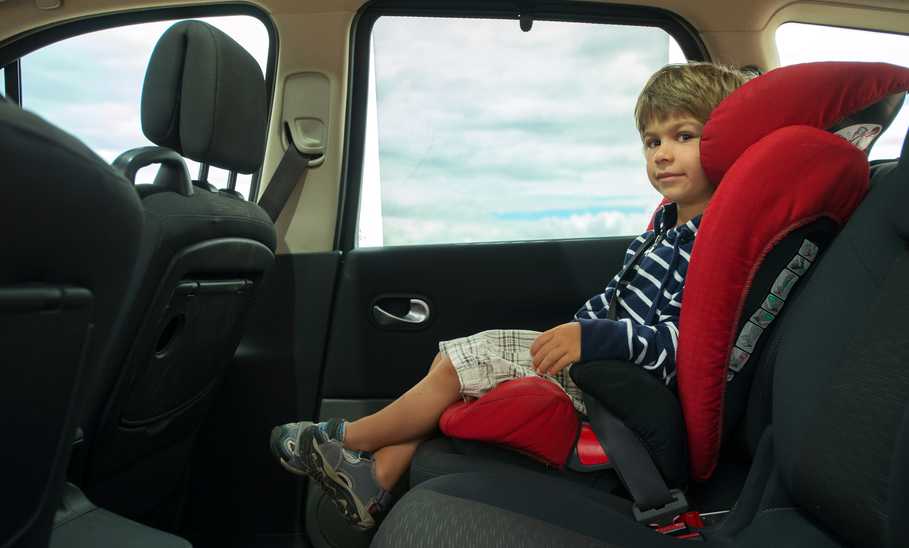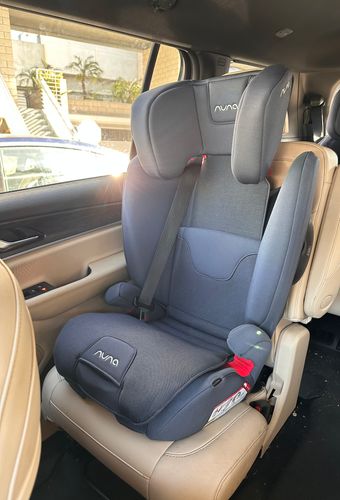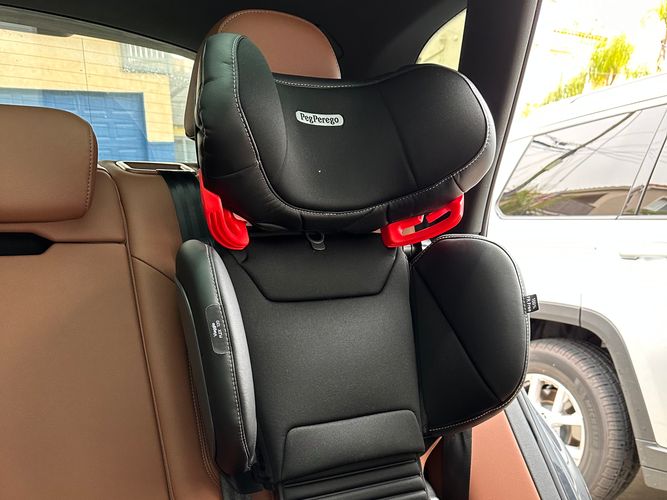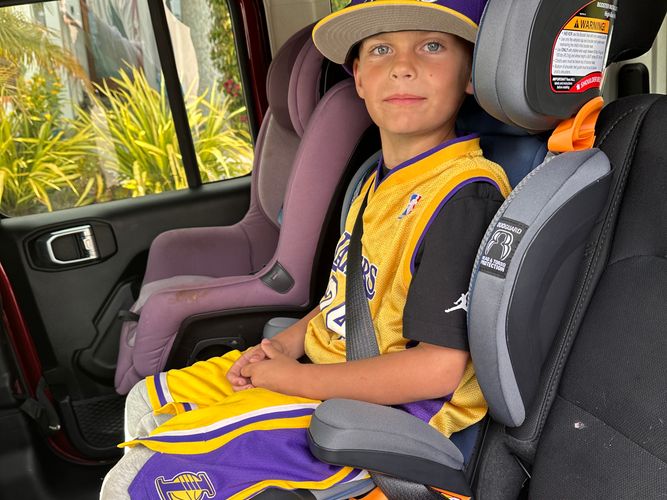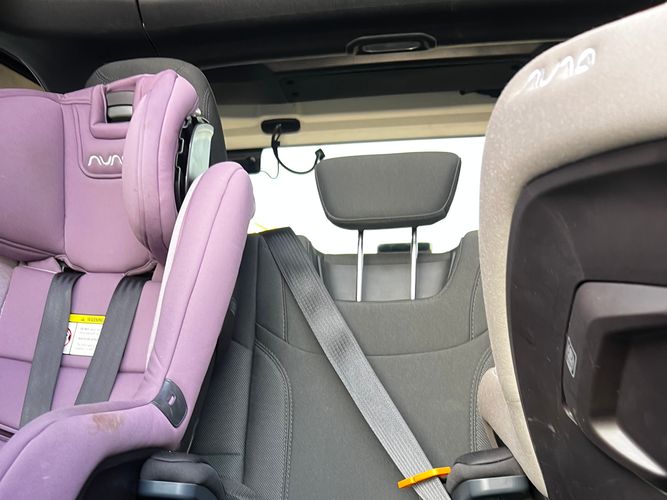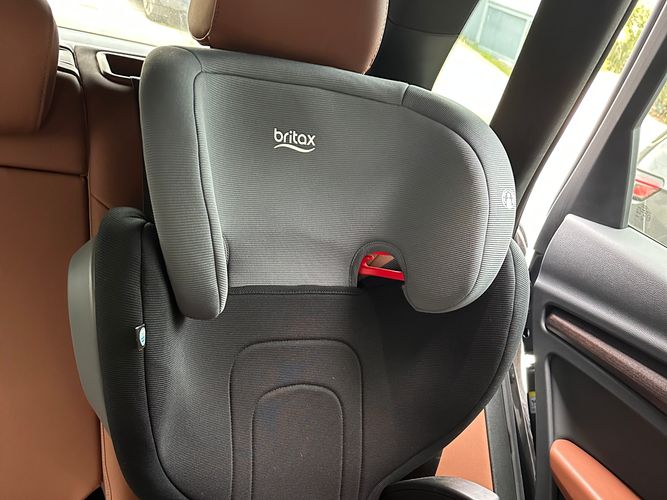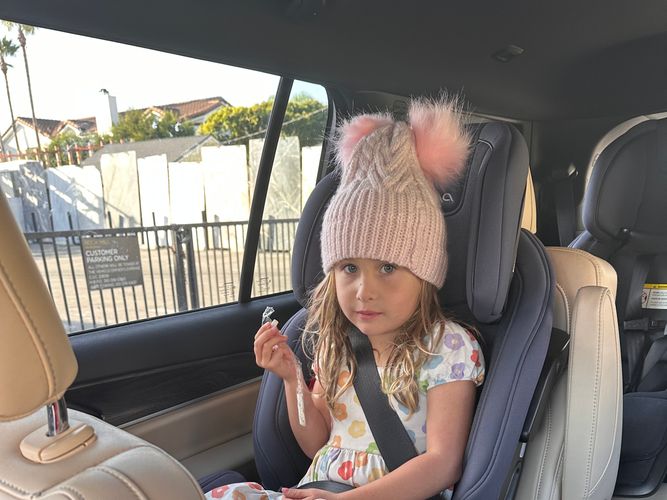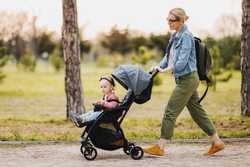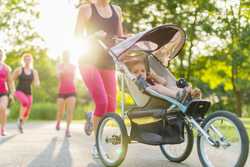I consider myself a pretty chill mom, but when it comes to car seat safety I’m definitely not laid back—not even in the slightest. My mom friends often refer to me as the car seat expert of the group, and it’s a known fact that I’ll happily check their booster and car seats for proper installation. The best booster seats meet and exceed all federal safety standards, are easy to use and install, comfortable for kids to ride in, and fit your child and vehicle properly — but more on that later.
My favorites are also easy on the eyes: with a sleek, modern design parents will appreciate, too. To curate this list, I put six best-selling booster seats, all recommended by child passenger safety technicians, to the test in multiple vehicles with my five-year-old and seven-year-old as testers. Read on for the full review of each and pro tips on buying the best booster seat for your family.
Our top picks for the best booster seats
Best booster seat for versatility: Nuna AACE

Nuna AACE
I’m a hardcore Nuna fan and there hasn’t been a Nuna product I’ve tested, from strollers to car seats, I haven’t loved. The gorgeous Nuna AACE exceeded my expectations and even my seven-year-old, who was super obsessed with his Nuna Exec (our best all-in-one pick), grew to love it. Some standout features that make the AACE a cut above the rest are ventilation panels for optimum airflow, the ability to adjust the seat depth (there are three different positions) to fit a broader range of children, particularly those with long legs, and the fact that it can be reclined in eight different positions when using LATCH so big kids can safely take car naps or just find a position that’s most comfortable for them.
Another cool feature is that instead of just growing vertically with your child, the AACE expands outward as the headrest is adjusted upwards, giving kids more shoulder room and space to spread out the older they get, though this can also be a downside if you’re limited on space in your vehicle and have another booster or car seat on either side.
I also appreciate that the Nuna AACE will fit in most vehicles, whereas some of the other booster seats I tested wouldn’t fit in my Jeep thanks to protruding, non-removable headrests. I even confirmed with a customer service rep that a gap between the seat back and the back of the booster is allowable when installed using the LATCH system, which I hope is helpful for other parents who have the same predicament.
Both my seven-year-old and five-year-old regularly ride in the AACE, and it’s simple to adjust the headrest height for a proper seat belt fit for each child. There are nine headrest positions in total, and my seven-year-old can easily thread the seatbelt through the shoulder belt guide and buckle up, though my five-year-old still needs help.
Overall, both kids report this seat is comfortable, and installation is a breeze with rigid lower anchors that turn green to let you know it’s properly secured. I haven’t used the seat in backless mode yet because neither of my children is 50 pounds (the minimum recommended weight for backless mode), but I do like that it’s an option for the future. I also appreciate the energy-absorbing side impact protection pods, which give me more peace of mind as a parent in case of an accident.
Specifications
- Dimensions: 15 x 21.5 x 26 inches
- Height and weight range: Ages 4+, 40–110 pounds for high-back booster; 50–120 pounds for backless booster; up to 60 inches
- Latch: Yes
- Product Weight: 15.6 pounds
- Colors: Four
- Side impact protection: Yes
- Convertible: Yes
- Price on publish: $250
Pros:
- Adjustable seat depth
- Expands at the shoulders as your child grows
- Easy to install and use
- Converts from high-back to backless
- Features eight recline positions
- Side impact protection pods
- Fits in my vehicle with protruding, non-removable headrests
Cons:
- Low armrest position may make it difficult for younger riders to buckle in
- The cup holder doesn’t fit most of my kids’ water bottles so we don’t use it
The bottom line:
The highly adjustable Nuna AACE looks great and performs even better with comfort and safety features kids and parents will both love.

Peg Perego Viaggio Flex 120
As a mom of three, I often need to fit three across, which is why I love the narrow, space-saving design of the Peg Perego Viaggio Flex 120. It fits great in the backseat of my husband’s Audi Q5 and is only 14 inches wide at the base, leaving plenty of space in the middle for another rider. Unlike any other booster seat on this list, it also folds up compact when not in use, which is great for storage or travel.
Where this narrow booster seat excels most is its high adjustability, with the ability to adjust in four different directions, all independent of one another, to accommodate the unique needs and body shapes of each child as they grow, whether they have a longer torso or longer legs. The headrest can be moved vertically to five different positions, while the upper backrest adjusts to three different positions and the side wings expand out to three positions. The seat also reclines in five positions for ultimate flexibility and comfort, including naps and the head support cradles the head to keep them in the proper position, even if they fall asleep.
My five-year-old daughter especially loves using this booster seat (and I love it for her), as it lacks armrests, making it much easier for her to buckle up all by herself. The seat is fairly lightweight at just 14 pounds and was a breeze to install with rigid LATCH, offering excellent stability for car rides and kids climbing in and out and over the seat constantly. I also like that my two-year-old, or anyone for that matter, can’t accidentally release the seat since the LATCH is equipped with a blind lock attaching system to prevent it from coming undone.
Safety-conscious parents like myself will appreciate the built-in side impact protection with kinetic pods to help move forces away from your child in case of a side collision. This seat looks really sleek in the car and features lots of comfortable padding so long rides aren’t a pain in the butt, literally.
Specifications
- Dimensions: 22 x 17.25 x 26.75 inches
- Height and weight range: 40-120 pounds and 39-63 inches
- Latch: Yes
- Weight: 14 pounds
- Colors: Five
- Side impact protection: Yes
- Convertible: No
- Price on publish: $299.99
Pros:
- Narrow, space-saving design is perfect for three across
- Sleek design with plenty of padding for kids’ comfort
- Highly adjustable in four different directions
- Folds down for compact storage and travel
- No armrests so kids can buckle independently
- Lightweight
Cons:
- Doesn’t convert to backless
- It’s pricey
The bottom line:
This sleek booster seat is perfect for small cars or fitting three across, with the ability to independently adjust in four different directions and no armrests so kids can buckle up with ease.

Chicco KidFit Adapt Plus
My seven-year-old gives this bestselling booster seat two thumbs up, noting it’s really comfortable for him to ride in and easy to buckle up when he uses it in our nanny’s Jeep. At just 17 inches wide, it’s also quite narrow for those who need a solid high-back booster that’s really reasonably priced and won’t take up a ton of precious backseat space.
Assembly was super simple straight out of the box, which isn’t always the case, taking mere minutes to put together. The seat can be used in both high-back mode or converted to a backless booster when your child is ready, saving you some money down the road. I like that the cupholders are actually usable and flexible so they can be folded in if you need to fit another seat next to it, which we almost always do. The seat itself is well cushioned with breathable mesh and adaptive fabric that helps regulate your kiddo’s temperature, keeping them cool or warm in the car depending on the season.
The LATCH connectors and one-pull tightener are fairly easy to use for a secure fit, and even easier to release with one hand if you need to quickly move the seat between cars. It’s also really lightweight at just ten pounds so taking it in and out isn’t a pain.
Specifications
- Dimensions: 17 x 17 x 26 inches
- Height and weight range: 40-100 pounds for high-back; 40-110 pounds for backless; 38-57 inches
- Latch: Yes
- Weight: 10 pounds
- Colors: Two
- Side impact protection: No
- Convertible: Yes
- Price on publish: $97.49
Pros:
- Flexible, deep and removable cup holders that can be folded in to save space
- Converts to a backless booster
- Temperature-regulating fabric
- Lots of cushioning for comfort
- Narrow footprint
- Affordably priced
Cons:
- Doesn’t allow for headrest interference so it wouldn’t fit in my Jeep Grand Cherokee L, which has non-removable and protruding headrests
- Max height is 57 inches, lower than other boosters on our list
The bottom line:
This comfortable booster seat offers excellent value, is lightweight and easy to move between vehicles and narrow enough to fit small back seats.
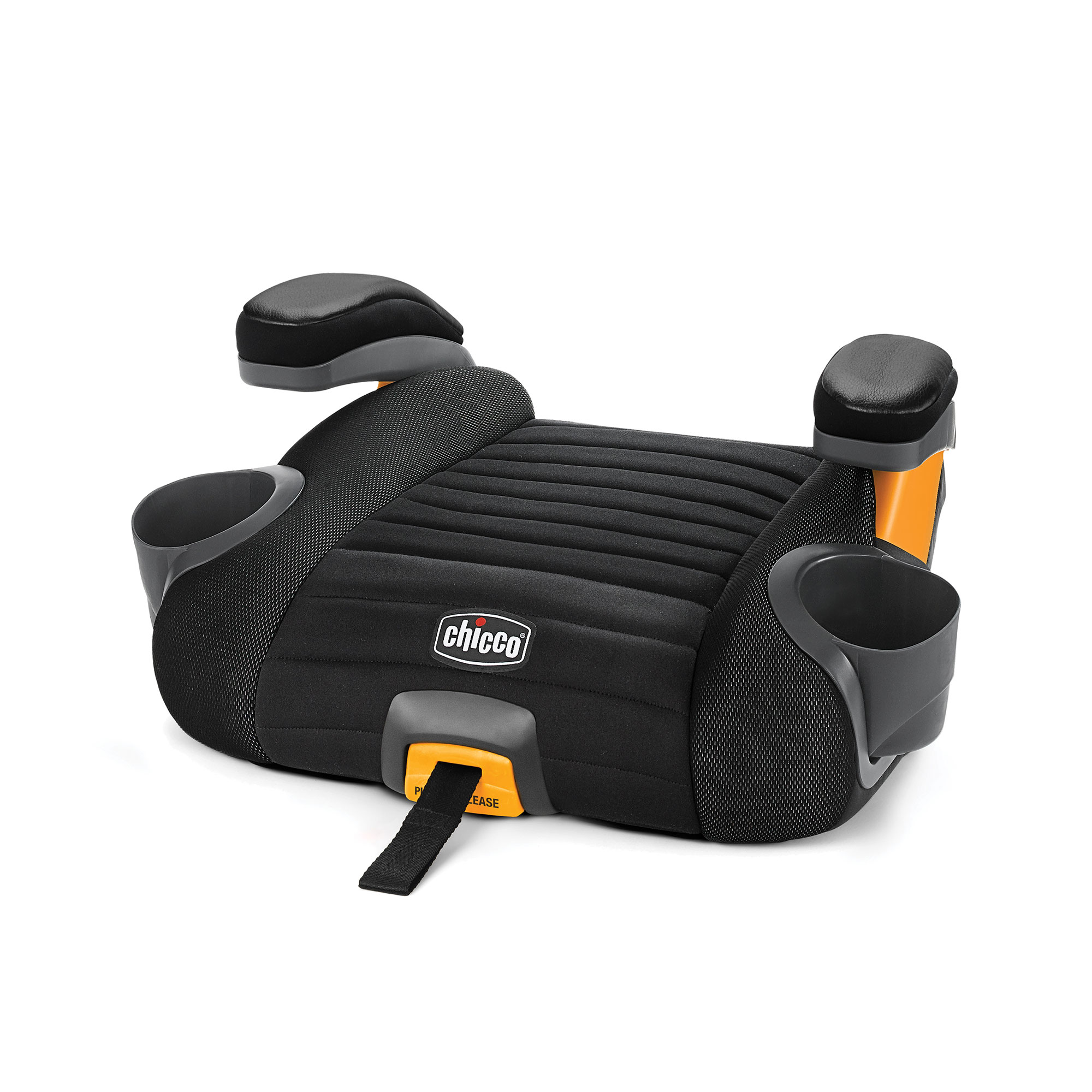
Chicco Gofit Plus
I heavily researched backless booster seats to use in our nanny’s car when all three of my kids are riding, as no high-back will fit in the middle with two car seats on the side. I wanted something narrow, super safe and with a shoulder belt clip so the seat belt would hit my seven-year-old(the oldest) in the right place instead of digging into his neck, which obviously isn’t safe and a big issue we experienced with a cheap Cosco booster I bought.
The Chicco Gofit Plus has honestly been a dream to use so far. I feel comfortable with my seven-year-old riding in it and he can comfortably use it by himself, even adjusting the shoulder belt clip for each ride. Due to our family’s needs, we use it in a center seat without the LATCH, but it always stays buckled in and my seven-year-old just climbs under the lap belt to buckle up or get out because buckling any booster squished in between two car seats every ride is, well, a nightmare. However, many reviewers report that the Quick-Release LATCH is simple to use to uninstall the seat (installation is also super simple), even for grandparents or novices. This is always the seat we grab for friends to use when they’re riding in my Jeep because it’s so easy to transport and move between vehicles.
While we don’t really ever use the cupholders because they have to be folded in for the seat to fit in the back row of our nanny’s car, I do love that they can hold many different sized water bottles and cups, which is a common complaint about other boosters.
Specifications
- Dimensions: 15 x 17 x 8.5 inches
- Height and weight range: 40-110 pounds; 38-57 inches
- Latch: Yes
- Weight: 5.5 pounds
- Colors: Three
- Side impact protection: Yes
- Convertible: No
- Price on publish: $53.99
Pros:
- Easy to install and uninstall
- Carry handle for traveling and transporting between vehicles
- Shoulder belt clip for proper seat belt fit
- Narrow design
- Cup holders fit a variety of water bottles and fold in to save more space
Cons:
- Lower height limit than other booster seats on our list, maxing out at 57 inches, which may not be ideal for tall kiddos
The bottom line:
This space-saving backless booster is equipped with a carry handle for easy transport, is effortless to install and uninstall and comes with a shoulder belt clip to properly position the seat belt.

Britax Skyline 2-Stage Belt-Positioning Booster Car Seat
Whether you’re big on safety or just have a kid who’s taller than average, the Britax Skyline is a great buy for the long run, as it can be used until your kid is over five feet (63 inches to be exact) and up to 120 pounds, which is tied with the Peg Perego Viaggio Flex 120 for the highest height and weight limits on our list. That said, this seat probably isn’t your best bet for big kids on the smaller side, as the minimum height it can be used in high-back mode is 44 inches. For reference, my five-year-old daughter, who is slightly above average in height, measured just 43.5 inches at her five year appointment.
I know looks aren’t everything, but this booster seat (like most Britax car seats) is a looker with a streamlined and chic design. The cover can be machine-washed and dried, which is great when you’re in a hurry and can’t wait for it to air dry or just don’t want to. It’s also incredibly effortless to install with the lower anchor connectors and features a color-coded belt guide so kids know exactly where to place the lap belt when buckling up. The 10-position headrest is easy to adjust as your kid grows or to accommodate different riders. The cup holders are removable too for easy cleaning, and the material is nice and plush for added comfort. At only 11 pounds, the seat is also pretty lightweight so it’s easy for me to take in and out the car and stick in a grandparent’s vehicle.
Specifications
- Dimensions: 16 x 19.5 x 27.5 inches
- Height and weight range: 40-120 pounds and 44-63 inches in high-back; 48-120 pounds and 46-63 inches in backless
- Latch: Yes
- Weight: 11 pounds
- Colors: One
- Side impact protection: Yes
- Convertible: Yes
- Price on publish: $108.37
Pros:
- Higher weight and height limits means longer use
- Converts from high-back to backless
- Cover can be machine washed and dried
- Easy to install with LATCH
- Sleek, modern design
- Plush, foam padding
- Color-coded vehicle belt guides for safe and easy buckling
Cons:
- Doesn’t allow for headrest interference, which is common with high-back boosters, so it couldn’t be installed in high-back mode in my Jeep Grand Cherokee L
- High minimum height limits so not great for smaller-than-average big kids
The bottom line:
With some of the highest height and weight limits on the market, the plush and premium Britax Skyline is a no-brainer if you’re big on safety or have a bigger than average kid.
Best all-in-one booster seat/car seat: Nuna Exec
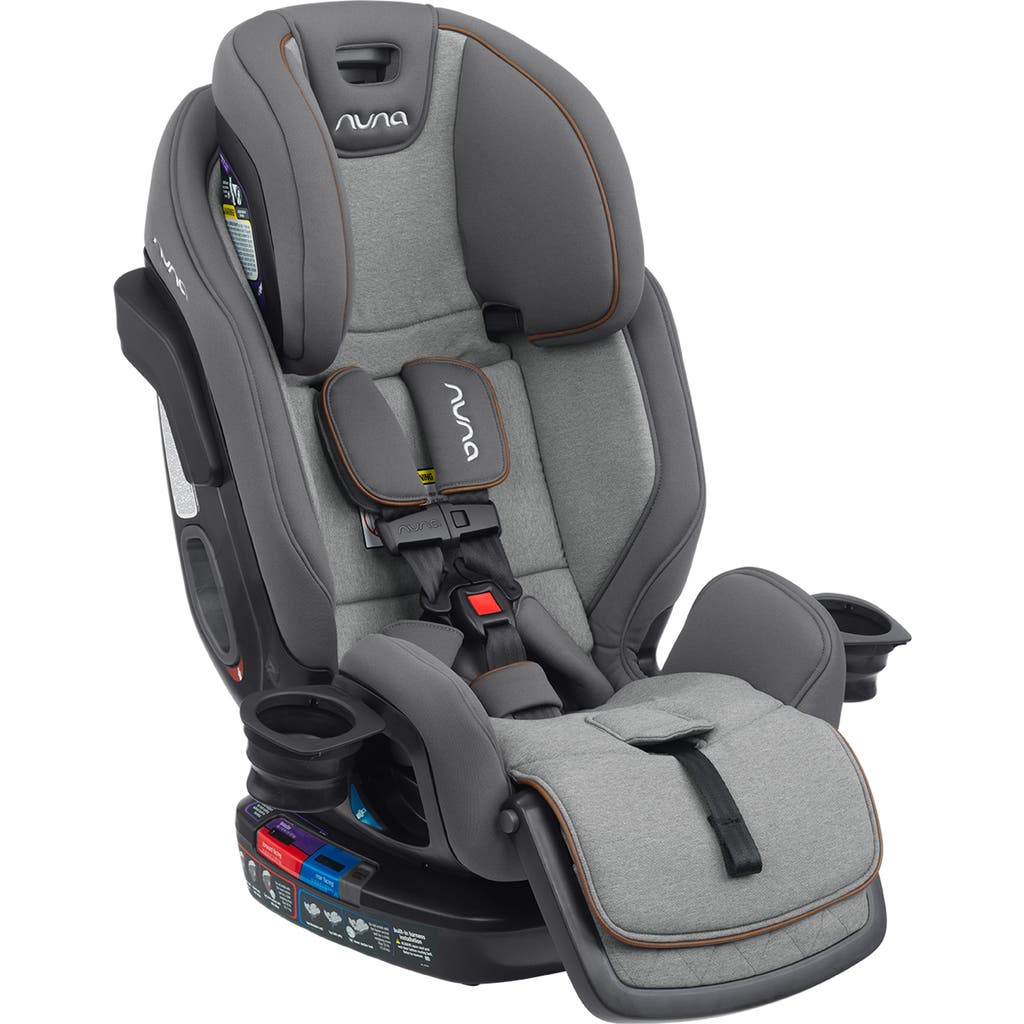
Nuna Exec
If it were up to my seven-year-old son, who prioritizes comfort, the luxe Nuna Exec all-in-one car seat would win best overall for the cushy padding and leg support alone. We recently converted ours to a rear-facing seat for his little brother and he regularly tells him he’s lucky to have it. We like the Nuna Exec model so much we have two of them, and have used them extensively in all three modes: rear-facing, forward-facing and booster. This is a premium seat that’s well worth the high price if you’re looking for a luxe all-in-one seat that can be used from birth as an infant car seat and then eventually passed on to a younger sibling once your big kid grows out of it height-wise, which they will and likely well before they’re ready to sit in a regular seat. For reference, my newly-turned seven-year-old is about 48 inches tall and was already using the booster on the highest headrest setting and probably only had a couple inches of growth left before he’d need to transition due to his shoulders reaching the shoulder belt guide height.
I will say, this booster is by far the easiest to adjust between kids with a 12-position head support. I think my son loves it because it’s the same seat he already knows and loves and is comfortable in; it’s just now being used with a seatbelt instead of a harness. It’s also much more substantial than your average booster seat so there’s just more plush padding and support there for car rides.
The built-in leg rest is such a game changer too, allowing kids to prop their legs up for support instead of just dangling, which can be uncomfortable after a while. There are four different recline positions for booster mode, so your kid can find their favorite or you can set it to whatever position works best with your particular vehicle’s seats.
Transitioning from rear or forward-facing mode to booster is easy enough by simply storing the harness behind the padding in dedicated slots and adjusting to the proper recline position for booster mode. Install in booster mode with the lower anchors is easy peasy too. Another bonus: no headrest interference even in my Jeep, which I attribute to the way the Exec’s headrest sits forward of the back of the booster seat so it eliminates the issue.
The Exec features lots of plush padding, is GREENGUARD Gold certified, and the shoulder belt guide is by far the easiest to use on our list because it’s spring loaded so you just gently push in to guide the belt through and there’s really no way for it to slide out without actively trying. The seat also boasts lots of safety features, including Aeroflex side impact protection pods, energy-absorbing EPP foam and no added fire retardant chemicals. At only 18.5-inches wide, you can easily fit three across in most cars.
Specifications
- Dimensions: 33 x 18.5 x 22.5 inches
- Height and weight range: 40-120 pounds and 38-57”
- Latch: Yes
- Weight: 26 pounds
- Colors: Five
- Side impact protection: Yes
- Convertible: Yes
- Price on publish: $750
Pros:
- Sleek, narrow design to fit three across
- Built-in leg support and multiple recline positions for added comfort
- Easy-to-use shoulder belt guide
- Plush padding is really comfortable for kids
- Lots of extra safety features
- Can be used from birth through the big kid stage
- Effortless to adjust between kids
Cons:
- While this seat says it accommodates kids up to 57 inches, my 48-inch seven-year-old son was close to outgrowing it in the highest shoulder belt guide position
- It’s costly
The bottom line:
This premium all-in-one seat has luxe comfort features big kids love, like a built-in leg rest, for smoother rides and is well worth it if you have multiple children who can eventually use it, too.
What to consider when buying a booster seat
If you’re able to, Jamie Grayson, a CPST (Child Passenger Safety Technician) and renowned baby gear expert, recommends taking your child with you when shopping for booster seats to test for fit and adjustments. If not, consider these key factors when shopping online.
Height and weight limits
Grayson says you’ll want to look at weight and height limits, especially taking into account the height of the shoulder belt guide (a clip-style attachment where the seatbelt is threaded through so it properly sits across the center of your child’s shoulder). Once your child’s shoulders are no longer below the shoulder belt guide on the highest headrest setting, then they’ve grown out of the seat and will need to move to a backless booster or a high-back with higher height limits.
LATCH system
Sarah Prowak, a CPST, parent coach and pediatric occupational therapist, finds booster seats that attach via a LATCH (lower anchors and tethers for children) system easiest to use with independence since they are anchored to the vehicle. This also comes into play when a child is not in the seat. “It ensures that the empty seat will not become a projectile during a crash or even just fly up when going over a bump. For boosters that do not attach via the LATCH system, they just need to be buckled back in when a child gets out of the vehicle,” she says.
Width of seat and armrests
The overall width of the booster seat is important for several reasons. “If it’s too wide it can be difficult for kids to buckle themselves in,” notes Grayson. Also, if you’re trying to fit three kids across or ensure a middle seat is still usable, a booster seat with a more narrow footprint might be best. On the other hand, if space isn’t a concern, a wider booster that can expand to grow with your kid might provide more comfort. Grayson also advises looking at the armrests. “Armrests are belt guides and can cause misuse if children aren’t instructed on how to properly buckle,” he says. For younger children, a booster seat without armrests, like the Peg Perego Viaggio Flex 120 reviewed above, can make it much easier for kids to buckle themselves in without help from adults (or in tighter spaces).
Ease of use
The best booster seats are straightforward for parents to install (and uninstall), easy for kids to buckle up and easily adjustable as children grow, or in my case, between two different-aged booster seat riders. Reading reviews from other parents is a good way to get a feel for these features and how easy the booster seat is to use in real life.
Comfort features
From experience as a mom of three, I can confidently say comfort is what kids care about the most and it makes for more enjoyable car rides for everyone. The newest booster seats have many thoughtfully-designed comfort features, from adjustable seat depth, side wings, and shoulder room to leg rests and reclining seats for car naps.
Vehicle headrests
“Protruding/non-removable headrests can be a big problem with booster seats, so take into account what your vehicle has,” advises Grayson. For example, in our nanny’s car, which has non-removable and protruding headrests it’s tough to find a booster seat that will fit tightly against the back of the vehicle seat, though our top pick, the Nuna AACE, does allow for a gap between the booster and seat back when using LATCH.
Convertibility
Many high-back booster seats can convert to backless boosters to grow with your child or to make traveling with a booster seat easier. (When traveling with little ones, it’s good to also have portable travel strollers and diaper bags for extra ease.)
There are also all-in-one and convertible car seats that can be used from birth through the big kid years so it’s something to consider when shopping if you have multiple children or plan for more.
What’s the difference between a harness, high-back, and backless booster seat?
Harness booster seats are typically referred to as all-in-one car seats, as they can convert from a five-point harness for babies, toddlers and preschoolers to a booster seat for big kids ages four and older and typically above 40 pounds. Most car seat passenger safety technicians will recommend maxing out your harness seat height and weight limits before transitioning your child to a booster, however.
When moving to a booster seat, Grayson suggests starting with a high-back booster for a few reasons, “primarily just because it helps ease the transition from a harnessed seat to a seatbelt by helping a child know their place in space/orientation a bit better. The sides of the seat also offer more support so if your child falls asleep they have those walls to hold them in place better than what a backless booster offers,” he says. “Some high-back booster seats also turn into backless, so take that into account when shopping.”
What are booster seat requirements
While requirements will differ based on where you live, generally speaking, most children who weigh between 40-80 pounds, are under 4'9” and are younger than age eight are required to be secured in a booster seat.
How to install a booster seat properly
When installing a booster seat, Grayson says to make sure it sits correctly in the seat by making proper contact with the seat and seatback. I do want to note, however, that some booster seats do allow for a gap between the back of the booster and seat back when used with LATCH so if you can’t remove your headrests and they’re protruding this is something to pay attention to when shopping (read the manuals).
“Some boosters require a head restraint behind the headrest and some do not,” adds Grayson. “If it does, you don’t want the head restraint pressing against or pushing the headrest of the booster forward. Some touching can be ok, but no pressure. Some boosters will allow for a little gap here if the headrest tilts forward. Sometimes you can take the vehicle's tilted head restraint out and turn it around and place it back to achieve a flat surface. Every seat has different rules regarding contact with the vehicle seat, so always read your manual and call the manufacturer if you have questions.”
When your child isn’t in the seat, Grayson says to buckle it down with the seatbelt so that it doesn’t become a projectile in a crash. “Better yet, get a booster with lower anchors so that you don’t have to worry about this.”
How we selected the best booster seats
To select the best booster seats, I homed in on a few important factors, from expert recs and real parent reviews to my personal experience as a mom of three and parenting writer who regularly reviews and tests all the latest and greatest baby and kids gear from a variety of brands.
Expert recommendations
To determine which seats to test, I asked a couple of car seat passenger safety technicians to share their favorite booster seats across different categories. As a parenting writer myself and a mom to three children, two of which are currently booster seat age, I also factored in my experience with various car seat brands and booster seats to select the contenders.
Research and reviews
Every booster seat on this list comes from a highly reputable brand and is backed by rave reviews from real parents and CPST’s alike. Most have hundreds, if not thousands, of positive reviews and have received an average star-rating of 4.4 or higher, with several receiving an impressive 4.8-average score.
Testing
Every seat on this list was personally tested by my five and seven-year-old children in multiple vehicles, including my Jeep Grand Cherokee L, my nanny’s Jeep Wrangler Willys and my husband’s Audi Q5. I considered factors like quality, ease of use, comfort and safety features, adjustability, vehicle fit and height/weight limits when making my selects.
Safety tips for using booster seats
First and foremost, you’ll want to make sure your booster seat fits properly on the vehicle seat (always check the manual) and is properly installed if using the LATCH system. Children should sit up straight with their back against the booster, advises Grayson. “Make sure the belt guide is above the child’s shoulders (think of placement around their ears/jawline as a gauge) and that the shoulder belt fits nicely across their torso. You must have a shoulder belt to use a booster, so don’t forget that. And make sure the child sits properly the entire time—no slouching or playing with the belt.”
Frequently asked questions (FAQs)
Which seat is safest for a booster seat?
“In terms of vehicle placement, you just want to make sure the booster is properly supported and there’s a shoulder and lap belt,” says Grayson. “Never use a booster with a lap belt only. And if you place it next to a sibling in another child restraint, make sure the booster age kid is aware not to accidentally undo the seatbelt the other car seat is using for installation.”
What age and weight is best for a booster car seat?
Although many manufacturers state four years old and 40 pounds, Grayson (and every CPST I’ve ever consulted) says you want to max out that forward-facing harness limit. “Do not rush into booster seat usage,” he warns. “Five or six years old is a much better timeframe for testing booster seat use/fit, but some kids won’t even be ready for them at that point. Evenflo also recently announced that moving forward their minimum age for booster seat usage is five, and that’s pretty rad—and more companies should follow suit, to be honest,” he says.
Juliana Amador, a certified car seat consultant at Car Seats & More, agrees. “Although manufacturers and even NHTSA tell us the minimum age is four, it's really not recommended at all. Children at four years old aren't mature enough, let alone their bodies are not developed yet to sustain a crash when harnessed only with a seatbelt.”
To know if your child is ready for a booster seat, they should ideally not fall asleep in the car often, if at all, anymore and be able to sit up straight in the proper position without leaning over, kicking their feet up or playing with the seatbelt.
What are the best seat protectors for booster seats?
If you need a vehicle seat protector, Grayson recommends first making sure your manufacturer allows them and then using it accordingly.
Is a backless booster seat safe?
Yes, when used properly backless booster seats are safe for older kids, however, Grayson always advises starting with a high-back. From personal experience, I’d recommend looking for a backless booster with a shoulder belt positioning clip to get the best seat belt fit.
